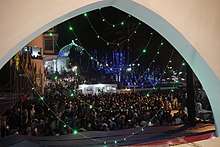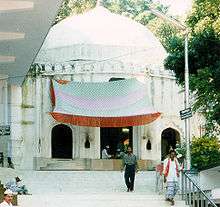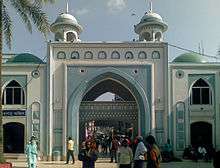Shah Jalal
Shaykh al-Mashāʾikh Makhdūm Shaykh Jalāl Mujarrad bin Muḥammad Kunyāī (Arabic: شيخ المشائخ مخدوم شيخ جلال مجرد بن محمد كنيائي)[1], popularly known as Shah Jalal, is a celebrated Sufi Muslim figure in Bengal. Shah Jalal's name is often associated with the Conquest of Sylhet and the spread of Islam into the region, part of a long history of interactions between the Middle East, Turkestan and South Asia.[2] Various complexes and religious places have been named after him, including the largest airport in Bangladesh, Hazrat Shahjalal International Airport.
Shaykh al-Mashāʾikh Makhdūm Shah Jalal Kunyāī | |
|---|---|
 Shah Jalal Mazar | |
| Other names | Shaykh Jalal |
| Personal | |
| Born | 25 May 1271 Place of birth is disputed. Most sources indicate either Konya (now in Turkey) or Hadhramaut (now in Yemen). |
| Died | 15 March 1346 (aged 74) Sylhet (now in Bangladesh) |
| Religion | Islam |
| Parents |
|
| Denomination | Sufi |
| Other names | Shaykh Jalal |
| Relatives | Jalaluddin Surkh-Posh Bukhari (maternal grandfather) |
| Muslim leader | |
| Based in | Jalalabad |
| Predecessor | Syed Ahmed Kabir Suhrawardi |
| Successor | Shah Paran |
Students
| |
| Post | Sufi saint, religious leader and mystic |
Early life and education
Jalal was said to have been born on 25 May 1271. Various traditions and historical documents differ in his place of birth. A number of scholars have claimed that he was born in Konya in modern-day Turkey (then in the Sultanate of Rum) and later moved to Greater Yemen either as a child or young adult. Many others believe he was born in a village called Kaninah in Hadhramaut, Yemen.[3]
His biography was first recorded in Sharḥ Nuzhat al-Arwāḥ (Commentary on the excursion of the souls) by Shaikh 'Ali Sher Bangali in 1571. The author was a descendant of one of Shah Jalal's senior companions, Haydar Ghazi. Thus, there is a gap of two centuries between the life of the saint and that of his earliest biographer. According to this account, Shah Jalal had been born in Turkestan, where he became a spiritual disciple of Ahmad Yasawi.[4]
His mother, Syeda Haseenah Fatimah, and his father, Mahmud ibn Muhammad ibn Ibrahim, were descendants of the Quraysh tribe in Makkah.[5] His mother was the daughter of Jalaluddin Surkh-Posh Bukhari.[6] Jalal's father was a cleric and contemporary of the Sufi mystic Rumi and died five years after his son's birth. Jalal was educated and raised by his maternal uncle, Syed Ahmad Kabir Suhrawardi. in Makkah.[7] He excelled in his studies; became a hafiz and mastered fiqh. He became a makhdoom, teacher of Sunnah and, for performing prayers in solitary milieu and leading a secluded life as an ascetic, al Mujarrad was post-fixed to his name. It is claimed he achieved spiritual perfection (Kamaliyyat) after 30 years of study, practice and meditation.[8]
Travel to South Asia
Jalal's maternal uncle, Syed Ahmad Kabir, gave him a handful of soil and asked him to travel to the Indian subcontinent. He instructed him to choose to settle and propagate Islam in any place in India where the soil exactly matches that which he gave him in smell and colour.[3] Shah Jalal journeyed eastward from Makkah and met many great scholars and Sufi mystics.[3] Sheikh Ali of Yemen gave up his duty as a prince to join Jalal on his expedition. Other disciples joining him from the Arabian peninsula included his nephew Shah Paran as well as Hafiz Muhammad Zakariya Arabi, Daud Qurayshi of Makkah, Sulayman Qarni and Kamal Pahlawan Yemeni. Jalal also came across Sheikh Chashni Pir, a pedologist who would check the soil of the places that Shah Jalal would visit in order to find the matching soil given by Sheikh Ahmad Kabir. Jalal passed through Baghdad and was present there during the time of the murder of the last Abbasid caliph Al-Musta'sim in 1258.[9] He gained a following here, including the likes of Shah Mustafa, Syed Ismail and Syed Yusuf. Driven off by the Mongol invasion of Baghdad, they continued journeying to the east. In Iran, the group was joined by Shah Kala and Shah Irani.
Jalal reached Uch in the Punjab, where he and many of his companions were initiated into the Sufi order of Suhrawardiyya.[10] Jalal was joined by many other disciples from more northerly places above Uch such as Syed Umar Samarqandi of Samarqand, Arif Multani of Multan, and Makhdum Zafar Ghaznawi of Ghazni. Shah Jalal then reached Gujarat, where he was joined by Shah Malum, and Narnaul where he met Shah Halim ad-Din Narnauli.
Shah Jalal then passed through Delhi where he was made a guest of the Sufi saint Nizamuddin Auliya and met Shah Gabru of Balochistan. Nizamuddin offered him a gift of two rare pigeons which would later be called Jalali Kobutor (Pigeons of Jalal). It is said that these pigeons continue to breed and its descendants remain around Jalal's dargah. Before reaching the Bengal, Jalal came across Haji Sheikh Shamsuddin Bihari who also joined him in the expedition.[7]
Conquest of Sylhet

In 1303, Sultan Shamsuddin Firoz Shah of Lakhnauti was engaged in a war with the neighbouring Gour Kingdom in the Sylhet region, then under the rule of the Hindu king Gour Govinda. This began when Shaykh Burhanuddin, a Muslim living in Sylhet, sacrificed a cow for his newborn son's aqiqah (birth celebration).[11] Govinda, in a fury for what he saw as sacrilege, had the newborn killed as well as having Burhanuddin's right hand cut off.[12]
When word of this reached Sultan Firoz Shah, an army commanded by his nephew, Sikandar Khan and later his Sipah Salar (Commander-in-chief) Syed Nasiruddin, was sent against Gour. Three successive strikes were attempted, all ending in failure due to the Bengali armies inexperience in the foreign terrain as well as Govinda's superior military strategy.[13][12]
A fourth attack, now with the aid of Shah Jalal and his companions (at this point numbering 360) was undertaken.[14] Jalal may have been summoned by Firoz Shah for aid after the initial failed attacks against Gour Govinda. Alternatively, he may already have been present in Sylhet, fighting against the Hindu king independently prior to being approached by the Sultan.[14][15] The combined Muslim forces ultimately claimed victory against Gour. Govinda was forced to retreat and Sylhet was brought under Muslim control. According to tradition, Shah Chashni Pir at this point compared the soil in Sylhet with that which was previously given to Jalal by his uncle, finding them to be identical. In any case, following the battle, Jalal and his followers settled in Sylhet.[11][14]
A Persian inscription from 1303 has since been discovered in Jalal's dargah. It mentioned Sikandar's victory in Arsah Srihat with the aid of the saint during the reign of Firoz Shah. This inscription can now be found in Bangladesh National Museum.[1]
Later life

During the later stages of his life, Jalal devoted himself to propagating Islam. The famous traveller Ibn Battuta, then in Satgaon,[16] made a one-month journey through the mountains of Kamarupa, north-east of Sylhet, to meet him.[17] On his way to Sylhet via Habung, Ibn Battuta was greeted by several of Jalal's disciples who had come to assist him on his journey many days before he had arrived. At the meeting in 1345, Ibn Battuta noted that Shah Jalal was tall and lean, fair in complexion and lived by the mosque in a cave, where his only item of value was a goat he kept for milk, butter, and yogurt. He observed that the companions of the Shah Jalal were foreign and known for their strength and bravery. He also mentions that many people would visit Jalal to seek guidance.[6] The meeting between Ibn Battuta and Shah Jalal is described in his Arabic travelogue, Rihla (The Journey).
Even today in Hadramaut, Yemen, Jalal's name is established in folklore.[18]
The exact date of his death is debated, but he is reported by Ibn Battuta to have died on 20 Dhul Qa'dah 746 AH (15 March 1346 CE).[19] He was buried in Sylhet in his dargah (tomb), which is located in a neighbourhood now known as Dargah Mahalla. Whether or not he has descendents is debated. He appointed his closest companion, Haji Muhammad Yusuf to be the khadim (guardian) of his dargah and Yusuf's descendants, the Sareqaum family, continue to have this role.
His shrine is famous in Sylhet and throughout Bangladesh, with hundreds of devotees visiting daily. He is buried next to four of his companions. The ex-Prince of Yemen, Shahzada Sheikh Ali to his south, Haji Yusuf to his east and Haji Khalil and Haji Dariya both to his west. The largest mosque in Sylhet was built at the Dargah (also one of the largest in Bangladesh).
Spiritual genealogy
Spiritual genealogy of Shah Jalal is as follows:
- Prophet Muhammad
- Ali ibn Abi Talib
- Hasan al-Basri
- Habib al-Ajami
- Maruf Karkhi
- Sirri Saqti
- Mumshad Al-Dinawari
- Sheikh Ahmad Aswad Dinnuri
- Sheikh Abu Muhammad Amwiya
- Sheikh Azi Uddin Shohrawardi
- Sheikh Abu Nazib Ziauddin
- Sheikh Hisab Al-Din
- Sheikh Makhdum
- Baha-ud-din Zakariya
- Jalaluddin Surkh-Posh Bukhari
- Sheikh Ahmad Kabir Suhrawardi
- Shah Jalal[21]
Eponyms
- Jalalabad, a historical name of Sylhet
- Jalalabad Ragib-Rabeya Medical College, private medical school
- Jalalabad Cantonment, Bangladesh Army military quarter
- Shahjalal Fertiliser Factory, Bangladesh's largest fertiliser factory, located in Fenchuganj
- Shah Jalal High School, secondary school in Jagannathpur
- Hazrat Shahjalal International Airport, Bangladeshi airport in Dhaka; nation's largest international gateway
- Shahjalal Islami Bank Limited, private commercial bank
- Shah Jalal Mosque & Islamic Cultural Centre, grade II listed mosque located in Cardiff, United Kingdom
- Shahjalal University of Science and Technology, Bangladeshi public university located in Sylhet
- Shahjalal Uposhahar, a neighbourhood in Ward 22, Sylhet
- Shahjalal Hall, University of Chittagong
Companions
Note: Brackets denote place of mazar
- Syed Nasiruddin, army commander of Shamsuddin Firuz Shah (Murarband, Chunarughat)
- Haydar Ghazi, second wazir of Sylhet (Sonargaon)
- Haji Yusuf, remained with Shah Jalal in Chowkidighi
- Ghazi Burhanuddin, first Muslim of Sylhet (Tultikar/Burhanabad, Ward 24)
- Shah Paran, his nephew (Khadimnagar, Sylhet Sadar)
- Aziz Chishti (Nij Gohorpur, Balaganj)
- Adam Khaki (Deorail, Badarpur)
- Syed Yaqub (Horipur, Barlekha)
- Shah Malum (Rajonpur, Fenchuganj)
- Shah Halimuddin (Kanihati, Kulaura)
- Shah Mustafa (Moulvibazar)
- Shah Gabru (Gabhurteki, Osmani Nagar)
- Shah Siddiq (Panchpara, Osmani Nagar)
- Khanda Jhokmok (Rainagar, Ward 19/20)
Later companions:
- Shah Kamal Quhafa (Shaharpara, Jagannathpur)
- Shah Tajuddin (Lama Tajpur, Osmani Nagar)
- Shah Ruknuddin (Kadamhata, Rajnagar)
See also
- Muhammad bin Bakhtiyar Khalji
- Moinuddin Chishti
- Sikandar Khan Ghazi
- Nizamuddin Auliya, his spiritual friend also gave him two pairs of black pigeons, later named Jalali kobutor
- Syed Nasiruddin
References
- Ahmad Hasan Dani. "Analysis of the Inscriptions". Asiatic Society Of Pakistan Vol-ii. pp. 7 and 103.
- Ahmed, Shamsuddin, Inscription of Bengal, vol. iv, Dhaka (1960), p 25
- Karim, Abdul (2012). "Shah Jalal (R)". In Islam, Sirajul; Jamal, Ahmed A. (eds.). Banglapedia: National Encyclopedia of Bangladesh (Second ed.). Asiatic Society of Bangladesh.
- Eaton, Richard M. (1993). The Rise of Islam and the Bengal Frontier, 1204–1760 (PDF). Berkeley: University of California Press. Archived from the original (PDF) on 21 June 2016.
- Rahman, M. F., Hazrat Shah Jalal and 360 Awliya, Deshkaal Publications, Sylhet, 1992, p.12-13
- Islam in South Asia in practice By – Barbara Daly Metcalf, Published – Princeton university press Uk 2009, Page 383 – 385.
- Muhammad Mojlum Khan (21 October 2013). "Shah Jalal". The Muslim Heritage of Bengal: The Lives, Thoughts and Achievements of Great Muslim Scholars, Writers and Reformers of Bangladesh and West Bengal. Kube Publishing. p. 23.
- Islam in South Asia in practice source of suhel-e-yamani By Barbara Daly Metcalf, Published by – Princeton universiti press, 2009. Page 385
- Ibn Battutah. The Rehla of Ibn Battuta.
He had seen Caliph al-Musta’sim Billah al-Abbasi at Baghdad, and that he was there at the time of his murder.
- Hanif, N., ed. (2000). "Jalal, Shaikh (d.1357 A.D.)". Biographical Encyclopaedia of Sufis: South Asia. New Delhi: Sarup & Sons. pp. 165–167. ISBN 81-7625-087-2.
- Hussain, M Sahul (2014). "Burhanuddin (R)". Banglapedia: National Encyclopedia of Bangladesh (Second ed.). Asiatic Society of Bangladesh.
- Hanif, N., ed. (2002). "Suharwardy Yemani Sylheti, Shaikhul Mashaikh Hazrat Makhdum Ghazi Shaikh Jalaluddin Mujjarad (1271-?)". Biographical Encyclopaedia of Sufis: Central Asia and Middle East. Vol. 2. New Delhi: Sarup & Sons. p. 459. ISBN 81-7625-266-2.
- Bangladesh Bureau of Statistics, Statistics Division, Ministry of Planning, Government of the People's Republic of Bangladesh,"Population Census of Bangladesh, 1974: District census report" (1979), p. 15
- Hanif (2002, p. 460)
- Wise, J (1873). "Note on Sháh Jalál, the patron saint of Silhaț". Journal of the Asiatic Society of Bengal. 42: 279.
- Hazrat Shah Jalal O Sylhet er Itihas by Syed Mujtaba Ali, re-published by Utsa Prakashan, Dhaka, 1988, p.60
- Rihla 9, 1344
- The rise of Islam and the Bengal frontier, 1204–1760, By Richard Maxwell Eaton, Published by – university of california press, page 76
- Rahman, M. F., Hazrat Shah Jalal and 360 Awliya, p.13, Deshkaal Publications, Sylhet, 1992
- Ziaul Haque, Md., Hazrat Shah Jalal (R.A): An Epic, p.114, Choitonno Publication, Sylhet, 2015
- Islam in South Asia in practice, By Barbara Daly Metcalf, Published by Princeton universiti press.
Further reading
| Wikimedia Commons has media related to Shah Jalal Mazar. |
- Sharḥ Nuzhat al-Arwāḥby 'Ali Sher Bangali (1517)
- Gulzar-i-Abrār by Muhammad Ghawthi Shattari (1613)
- Suhail-i-Yaman by Nasir ad-Din Haydar (1860)
- Risālat by Muhiy ad-Din Khadim (1711)
- Rauzat-us-Salatin